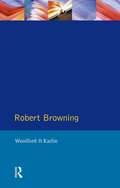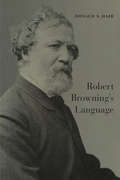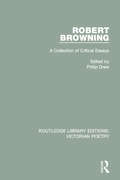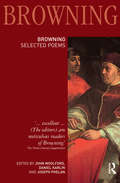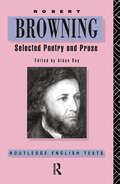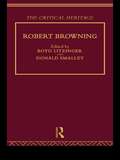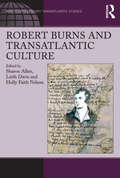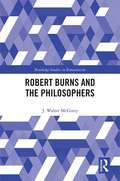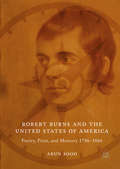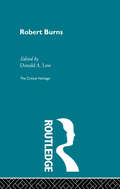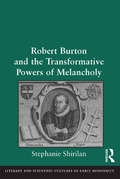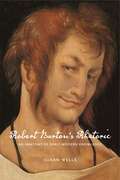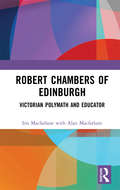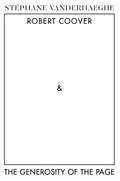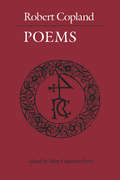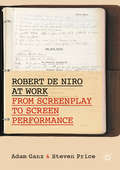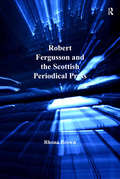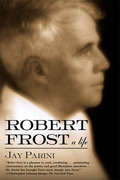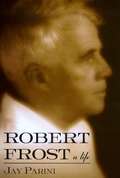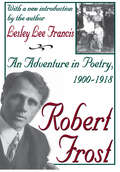- Table View
- List View
Robert Browning (Studies In Eighteenth and Nineteenth Century Literature Series)
by John Woolford Daniel KarlinRobert Browning (1812-89) rivals Tennyson as the major Victorian poet with such important works as Dramatic Lyrics, Dramatic Romances and Lyrics, Men and Women, Dramatic Personae and the monumental The Ring and the Book. He is known for his development of the dramatic monologue in which he recreated the world of Renaissance Italy, and provided subtle and complex explorations of character. Here, Daniel Karlin and John Woolford provide a thematic survey of Browning's often difficult work, using key poems as a common point of reference. The themes covered include: styles, genres, the mind, the world, interaction and criticism. This excellent survey will be of value to students of Victorian literature and modernism.
Robert Browning's Language
by Donald S. HairWhat are the influences that shaped the language used by one of the nineteenth century's greatest writers? How did his religious beliefs, the books he owned, the paintings and music he loved, affect almost sixty years' output of poems, plays, essays, and letters? This book attempts to define Browning's understanding of the nature and use of words and syntax by considering not only a full range of texts from the 1833 Pauline to the 1889 Asolando, but also the ideas important to Browning, the historical context in which he lived, and the other artistic passions that played a part in his life. In this companion volume to Tennyson's Language, Donald Hair establishes Browning's place at the crossroads between empirical and idealist traditions and explains his "double view" of language, arguing that both Locke and the Congregationalists found language to be at the same time empty and a God-given essential. The Victorian age's anti-theatrical bias, which Browning came to share, and his reading of predecessors, principally Quarles, Bunyan, Donne, and Smart, also shaped his understanding of the diction of poetry. Hair conceives of Browning's language as a theoretical whole, encompassing words, genres, rhyme, syntax, and phonetics. He also links Browning's interest in music with his rhyming, the most essential and characteristic feature of his prosody, and relates his interest in painting to the interpretation of the visual image in the emblem and in typology.
Robert Browning's Poetry (SparkNotes Literature Guide Series)
by SparkNotesRobert Browning's Poetry (SparkNotes Literature Guide) by Robert Browning Making the reading experience fun! Created by Harvard students for students everywhere, SparkNotes is a new breed of study guide: smarter, better, faster. Geared to what today's students need to know, SparkNotes provides: *Chapter-by-chapter analysis *Explanations of key themes, motifs, and symbols *A review quiz and essay topicsLively and accessible, these guides are perfect for late-night studying and writing papers
Robert Browning: A Collection of Critical Essays (Routledge Library Editions: Victorian Poetry #1)
by Philip DrewFirst published in 1966. This title complies a selection of critical articles by various authors on the poetry of Robert Browning. The editor has collected a number of important general studies of Browning’s mind and art by English and American critics, as well as studies on individual poems. This book will be of interest to students of literature.
Robert Browning: Selected Poems (Longman Annotated English Poets)
by Joseph Phelan John Woolford Daniel KarlinRobert Browning (1812 – 1889) was one of the defining figures of the Victorian age. Famous in his lifetime for his elopement and marriage to Elizabeth Barratt, his critical reputation grew steadily in the years following her early death. Browning’s mastery of dramatic verse was evident throughout his career, from such chillingly unforgettable monologues as ‘My Last Duchess’ and ‘Porphyria’ to the mature work included in his collection Dramatis Personae. This selection, chosen by leading scholars, reveals the innovation, complexity and profound psychological insight that have ensured Browning’s enduring reputation and his continuing appeal to readers today. Browning: Selected Poems results from a completely fresh appraisal of the canon, text and context of the writer’s work. The poems are presented in the order of their composition and in the text in which they were first published, giving a unique insight into the development of Browning’s art. An introduction and chronology offer useful background material, whilst annotations and headnotes provide details of composition, publication, sources and contemporary reception. This authoritative yet accessible selection should become the first point of reference for scholar, student and general reader alike.
Robert Browning: Selected Poetry and Prose
by Robert BrowningFirst Published in 1991. This edition draws upon a wide range pf Browning's poetry and prose, inducing selections from his 'Dramatic Lyrics', 'Dramatic Romances and Lyrics' and 'Men and Women' and 'Dramatis Personae' collections, as well as extracts from his correspondence with Elizabeth Barrett. Aidan Day's introduction chronicles the events both of Browning's life and of his development as a poet.
Robert Browning: The Critical Heritage (Critical Heritage Ser.)
by Boyd Litzinger Donald SmalleyFirst published in 1995. Routledge is an imprint of Taylor & Francis, an informa company.
Robert Burns and Transatlantic Culture (Ashgate Series In Nineteenth-century Transatlantic Studies)
by Sharon Alker Leith DavisWhile recent scholarship has usefully positioned Burns within the context of British Romanticism as a spokesperson of Scottish national identity, Robert Burns and Transatlantic Culture considers Burns's impact in the United States, Canada, and South America, where he has served variously as a site of cultural memory and of creative negotiation. Ambitious in its scope, the volume is divided into five sections that explore: transatlantic concerns in Burns's own work, Burns's early publication in North America, Burns's reception in the Americas, Burns's creation as a site of cultural memory, and extra-literary remediations of Burns, including contemporary digital representations. By tracing the transatlantic modulations of the poet and songwriter and his works, Robert Burns and Transatlantic Culture sheds new light on the circuits connecting Scotland and Britain with the evolving cultures of the Americas from the late eighteenth century to the present.
Robert Burns and the Philosophers (Routledge Studies in Romanticism)
by J Walter McGintyThis volume expounds the influence of Robert Burns’s reading of Philosophy on his life and work, supplementing this with his personal encounters with those philosophers he met. The work begins with the Homespun Philosophy of his early years under the tutelage of William Burnes and John Murdoch, then examines in detail some of the texts of John Locke, Adam Smith and Francis Hutcheson, including other writers who reflect Hutcheson’s thinking. Further chapters include the exploration on Thomas Reid, Dugald Stewart, Archibald Alison and William Greenfield. Robert Burns and the Philosophers does not purport to be a work of philosophy but rather to show the poet’s reaction to the subject and the development of his understanding. This work opens up a subject that hitherto has been almost unexplored.
Robert Burns and the United States of America: Poetry, Print, and Memory 1786–1866
by Arun SoodThis book provides a critical study of the relationship between Robert Burns and the United States of America, c.1786-1866. Though Burns is commonly referred to as Scotland’s “National Poet”, his works were frequently reprinted in New York and Philadelphia; his verse mimicked by an emerging canon of American poets; and his songs appropriated by both abolitionists and Confederate soldiers during the Civil War era. Adopting a transnational, Atlantic Studies perspective that shifts emphasis from Burns as national poet to transnational icon, this book charts the reception, dissemination and cultural memory of Burns and his works in the United States up to 1866.
Robert Burns: The Critical Heritage (Critical Heritage Ser.)
by Donald A. LowThe Critical Heritage gathers together a large body of critical sources on major figures in literature. Each volume presents contemporary responses to a writer's work, enabling students and researchers to read for themselves, for example, comments on early performances of Shakespeare's plays, or reactions to the first publication of Jane Austen's novels.The carefully selected sources range from landmark essays in the history of criticism to journalism and contemporary opinion, and little published documentary material such as letters and diaries. Significant pieces of criticism from later periods are also included, in order to demonstrate the fluctuations in an author's reputation.Each volume contains an introduction to the writer's published works, a selected bibliography, and an index of works, authors and subjects.
Robert Burton and the Transformative Powers of Melancholy (Literary and Scientific Cultures of Early Modernity)
by Stephanie ShirilanFew English books are as widely known, underread, and underappreciated as Robert Burton’s The Anatomy of Melancholy. Stephanie Shirilan laments that modern scholars often treat the Anatomy as an unmediated repository of early modern views on melancholy, overlooking the fact that Burton is writing a cento - an ancient form of satire that quotes and misquotes authoritative texts in often subversive ways - and that his express intent in so doing is to offer his readers literary therapy for melancholy. This book explores the ways in which the Anatomy dispenses both direct physic and more systemic medicine by encouraging readers to think of melancholy as a privileged mental and spiritual acuity that requires cultivation and management rather than cure. Refuting the prevailing historiography of anxious early modern embodiment that cites Burton as a key witness, Shirilan submits that the Anatomy rejects contemporary Neostoic and Puritan approaches to melancholy. She reads Burton’s erraticism, opacity, and theatricality as modes of resistance against demands for constancy, transparency, and plainness in the popular literature of spiritual and moral hygiene of his day. She shows how Burton draws on rhetorical, theological, and philosophical traditions that privilege the transformative powers of the imagination in order to celebrate melancholic impressionability for its capacity to inspire and engender empathy, charity, and faith.
Robert Burton’s Rhetoric: An Anatomy of Early Modern Knowledge (RSA Series in Transdisciplinary Rhetoric #12)
by Susan WellsPublished in five editions between 1621 and 1651, The Anatomy of Melancholy marks a unique moment in the development of disciplines, when fields of knowledge were distinct but not yet restrictive. In Robert Burton’s Rhetoric, Susan Wells analyzes the Anatomy, demonstrating how its early modern practices of knowledge and persuasion can offer a model for transdisciplinary scholarship today.In the first decades of the seventeenth century, Robert Burton attempted to gather all the existing knowledge about melancholy, drawing from professional discourses including theology, medicine, and philology as well as the emerging sciences. Examining this text through a rhetorical lens, Wells provides an account of these disciplinary exchanges in all their subtle variety and abundant wit, showing that questions of how knowledge is organized and how it is made persuasive are central to rhetorical theory. Ultimately, Wells argues that in addition to a book about melancholy, Burton’s Anatomy is a meditation on knowledge.A fresh interpretation of The Anatomy of Melancholy, this volume will be welcomed by scholars of early modern English and the rhetorics of health and medicine, as well as those interested in transdisciplinary work and rhetorical theory.
Robert Burton’s Rhetoric: An Anatomy of Early Modern Knowledge (RSA Series in Transdisciplinary Rhetoric)
by Susan WellsPublished in five editions between 1621 and 1651, The Anatomy of Melancholy marks a unique moment in the development of disciplines, when fields of knowledge were distinct but not yet restrictive. In Robert Burton’s Rhetoric, Susan Wells analyzes the Anatomy, demonstrating how its early modern practices of knowledge and persuasion can offer a model for transdisciplinary scholarship today.In the first decades of the seventeenth century, Robert Burton attempted to gather all the existing knowledge about melancholy, drawing from professional discourses including theology, medicine, and philology as well as the emerging sciences. Examining this text through a rhetorical lens, Wells provides an account of these disciplinary exchanges in all their subtle variety and abundant wit, showing that questions of how knowledge is organized and how it is made persuasive are central to rhetorical theory. Ultimately, Wells argues that in addition to a book about melancholy, Burton’s Anatomy is a meditation on knowledge.A fresh interpretation of The Anatomy of Melancholy, this volume will be welcomed by scholars of early modern English and the rhetorics of health and medicine, as well as those interested in transdisciplinary work and rhetorical theory.
Robert Chambers of Edinburgh: Victorian Polymath and Educator
by Iris MacfarlaneThis is a book on the life and times of Robert Chambers, founder of W. & R. Chambers publishers. Although there are now books based on some of his letters and on the impact of one of his books, The Vestiges of Natural Creation, there are no books on the whole man and his life. Written by Iris Macfarlane with Alan Macfarlane, the book weaves together three strands. At one level, it is a biography of Chambers and his family; the portrait of a rise from absolute poverty to great wealth and influence. At the second it provides the context of his life by the way of a portrait of nineteenth century Edinburgh as seen through his eyes. At the third it explores the intellectual and organisational revolutions embodied in his life, the explorations in history, folklore, geology, publishing, education and many other fields which made him one of the most exciting thinkers of his age. It is based on extensive archival research among the Chambers’ archives in Edinburgh and conversations with his descendants.Please note: This title is co-published with Social Science Press, New Delhi. Taylor & Francis does not sell or distribute the Hardback in India, Pakistan, Nepal, Bhutan, Bangladesh and Sri Lanka.
Robert Coover and the Generosity of the Page
by Stephane VanderhaegheRobert Coover and the Generosity of the Page is an unconventional study of Robert Coover's work from his early masterpiece The Origin of the Brunists (1966) to the recent Noir (2010). Written in the second person, it offers a self-reflexive investigation into the ways in which Coover's stories often challenge the reader to resist the conventions of sense-making and even literary criticism. By portraying characters lost in surroundings they often fail to grasp, Coover's work playfully enacts a "(melo)drama of cognition" that mirrors the reader's own desire to interpret and make sense of texts in unequivocal ways. This tendency in Coover's writing is indicative of a larger refusal of the ready-made, of the once-and-for-all or the authoritative, celebrating instead, in its generosity, the widening of possibilities--thus inevitably forcing the reader-critic to acknowledge the arbitrariness and artificiality of her responses.
Robert Coover and the Generosity of the Page
by Stephane VanderhaegheRobert Coover and the Generosity of the Page is an unconventional study of Robert Coover's work from his early masterpiece The Origin of the Brunists (1966) to the recent Noir (2010). Written in the second person, it offers a self-reflexive investigation into the ways in which Coover's stories often challenge the reader to resist the conventions of sense-making and even literary criticism. By portraying characters lost in surroundings they often fail to grasp, Coover's work playfully enacts a "(melo)drama of cognition" that mirrors the reader's own desire to interpret and make sense of texts in unequivocal ways. This tendency in Coover's writing is indicative of a larger refusal of the ready-made, of the once-and-for-all or the authoritative, celebrating instead, in its generosity, the widening of possibilities--thus inevitably forcing the reader-critic to acknowledge the arbitrariness and artificiality of her responses.
Robert Coover and the Generosity of the Page
by Stephane VanderhaegheRobert Coover and the Generosity of the Page is an unconventional study of Robert Coover's work from his early masterpiece The Origin of the Brunists (1966) to the recent Noir (2010). Written in the second person, it offers a self-reflexive investigation into the ways in which Coover's stories often challenge the reader to resist the conventions of sense-making and even literary criticism. By portraying characters lost in surroundings they often fail to grasp, Coover's work playfully enacts a "(melo)drama of cognition" that mirrors the reader's own desire to interpret and make sense of texts in unequivocal ways. This tendency in Coover's writing is indicative of a larger refusal of the ready-made, of the once-and-for-all or the authoritative, celebrating instead, in its generosity, the widening of possibilities--thus inevitably forcing the reader-critic to acknowledge the arbitrariness and artificiality of her responses.
Robert Copland: Poems
by Robert Copland Mary ErlerRobert Copland is (fl. 1505-1546) had a long career as a poet, translator, and printer, and his achievements were substantial. As a printer, he worked for and with Wynkyn de Worde, and his editions look back to the work of Caxton, de Worde's master, and forward, through the work of his successor William Copland, to the Elizabethan period. As a translator, he worked at a time when foreign languages were becoming increasingly necessary to the average Englishman. John Berdan calls Copland one of the main channels of French influence in England during this period. This book makes available the lively poetry of a pre-Renaissance world. In includes lyl of Braintfords Testament, a bequest of farts poem indebted to Chaucer's Summoner's Tale; The Seuen Sorowes That Women Haue When Theyr Husbandes Be Deade, in which conventional misogynist satire moves into psychological complexity; and Copland's most important work, The Hye Way to the Spyttell Hous, an account of vagabond life outside the law in which thieves' cant first sees print. All Copland's work displays a singularly personal quality: as H.R. Plomer says, 'The voice of Robert Copland imparts life to the faint outline that we have of him.' Additional information is contained in the biographical material and notes and glossary. This is a valuable contribution to social history and will be of special interest to those concerned with the early history of English printing.
Robert De Niro at Work: From Screenplay to Screen Performance (Palgrave Studies in Screenwriting)
by Steven Price Adam GanzRobert De Niro and the Working Screenplay is the first critical study to examine how Robert de Niro, perhaps the finest screen actor of his generation, works with screenplays to imagine, prepare and denote his performance. In categorising the various ways in which De Niro works with a screenplay, this book will re-examine the relationship between actor and text. This book considers the screenplay as above all a working document and a material object, present at every stage of the filmmaking process. The working screenplay goes through various iterations in development and exists in many versions on set, each adapted and personalised for the specific use of the individual and their role. As the archive reveals, nobody works more closely with the script than the actor, and no actor works more on a script than De Niro.
Robert Fergusson and the Scottish Periodical Press
by Rhona BrownThough Robert Fergusson published only one collection of poems during his lifetime, he was a fixture in the Scottish periodical press. Rhona Brown explores Fergusson's poetic output in its immediate periodical context, enabling a new understanding of Fergusson's contribution to poetry that also enlarges on our understanding of the Scottish periodical press. Focusing on the development of his career in Walter Ruddiman's Weekly Magazine, Brown situates Fergusson's poetry alongside contemporary events that expose Fergusson's preoccupations with the frivolities of fashion, theatrical culture, the economic status of Scottish manufacture, and politics. At the same time, Brown offers fascinating insights into the political climate of Enlightenment Scotland and shows the Weekly Magazine in relationship to the larger Scottish and British periodical milieus. She concludes by exploring reactions to Fergusson's death in the British periodical presses, arguing that contrary to critical consensus, the poet's death was ignored neither by his own country nor by the larger literary community.
Robert Frost
by Jay PariniThis fascinating reassessment of America's most popular and famous poet reveals a more complex and enigmatic man than many readers might expect. Jay Parini spent over twenty years interviewing friends of Robert Frost and working in the poet's archives at Dartmouth, Amherst, and elsewhere to produce this definitive and insightful biography of both the public and private man. While he depicts the various stages of Frost's colorful life, Parini also sensitively explores the poet's psyche, showing how he dealt with adversity, family tragedy, and depression. By taking the reader into the poetry itself, which he reads closely and brilliantly, Parini offers an insightful road map to Frost's remarkable world.
Robert Frost in Context
by Mark RichardsonThis new critical volume offers a fresh, multifaceted assessment of Robert Frost's life and works. Nearly every aspect of the poet's career is treated: his interest in poetics and style; his role as a public figure; his deep fascination with science, psychology, and education; his peculiar and difficult relation to religion; his investments, as thinker and writer, in politics and war; the way he dealt with problems of mental illness that beset his sister and two of his children; and, finally, the complex geo-political contexts that inform some of his best poetry. Contributors include a number of influential scholars of Frost, but also such distinguished poets as Paul Muldoon, Dana Gioia, Mark Scott, and Jay Parini. Essays eschew jargon and employ highly readable prose, offering scholars, students, and general readers of Frost a broadly accessible reference and guide.
Robert Frost: A Life
by Jay Parini"I have tried to understand how Frost got from day to day and from poem to poem, tracing his rich, always developing, intellectual and artistic life over many decades. My intention was not to supplant or overtake previous biographers and critics but merely to add a significant layer. I can say without fear of exaggeration that this life of Frost was a labor of love. It is one of the few books I have ever finished with deep reluctance."
Robert Frost: An Adventure in Poetry, 1900-1918
by Lesley Lee FrancisIn this volume, Lesley Lee Francis, granddaughter of Robert Frost, brings to life the Frost family's idyllic early years. Through their own words, we enter the daily lives of Robert, known as RF to his family and friends, his wife, Elinor, and their four children, Lesley, Carol, Irma, and Marjorie. The result is a meticulously researched and beautifully written evocation of a fleeting chapter in the life of a literary family.Taught at home by their father and mother, the Frost children received a remarkable education. Reared on poetry, nurtured on the world of the imagination, and instructed in the art of direct observation, the children produced an exceptional body of writing and artwork in the years between 1905 and 1915. Drawing upon previously unexamined journals, notebooks, letters, and the little magazine entitled The Bouquet produced by the Frost children and their friends, Francis shows how the genius of Frost was enriched by his interactions with his children. Francis depicts her grandfather as a generous, devoted, and playful man with a striking ability to communicate with his children and grandchildren. She traces the family's adventures from their farm years in New Hampshire through their nearly three years in England. This enchanting evocation of the Frost family's life together makes more poignant the unforeseen personal tragedies that would befall its members in later years.
